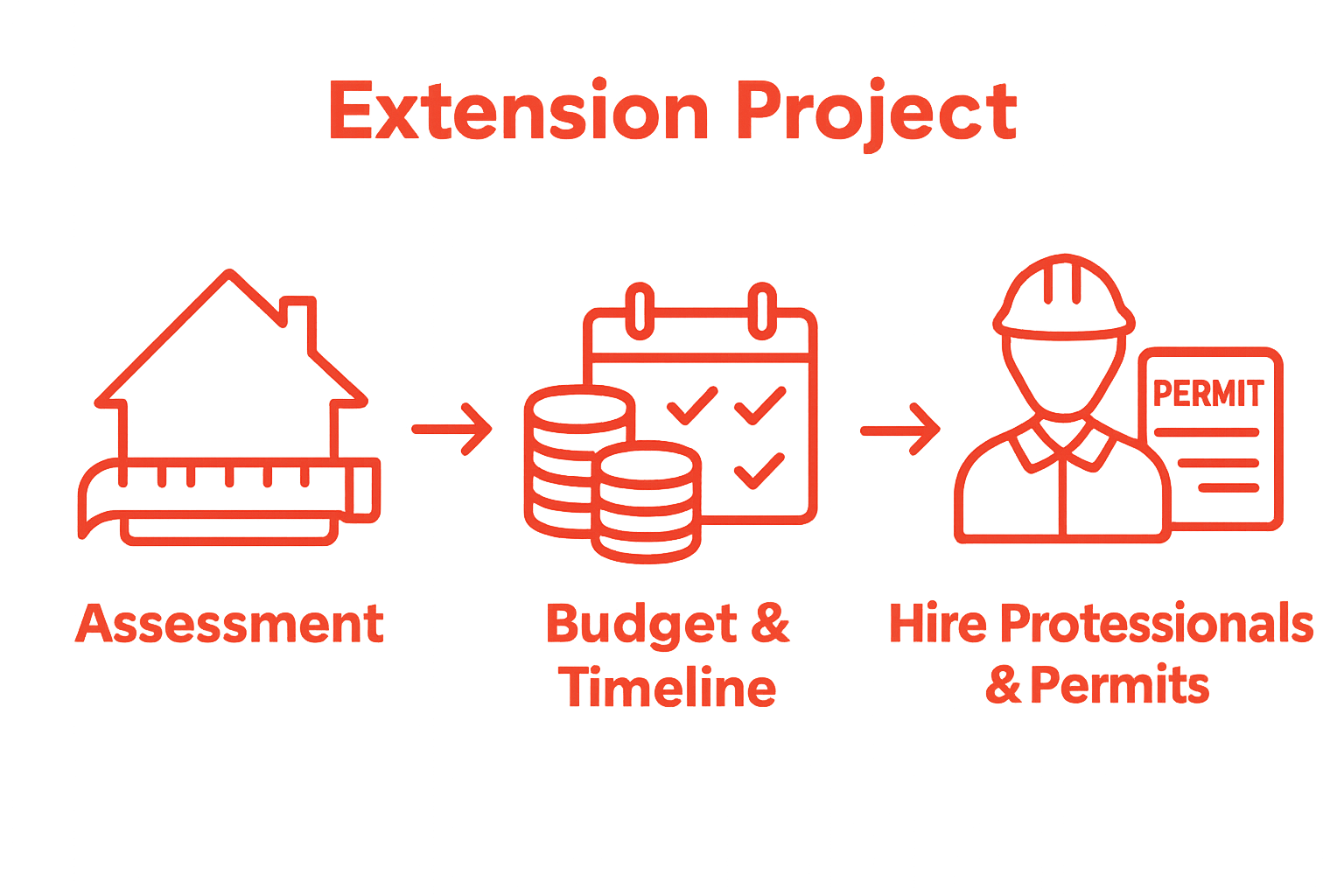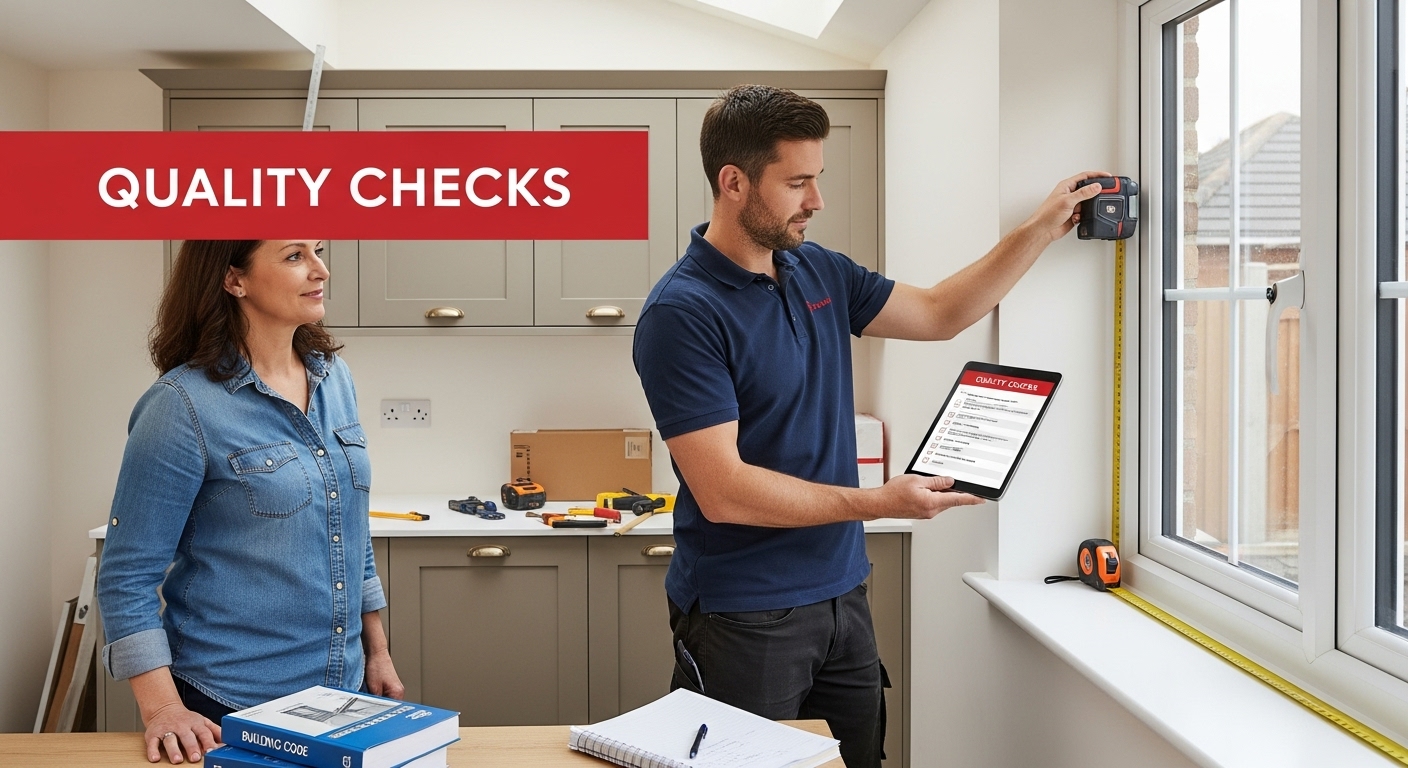Thinking about expanding your home is exciting and a bit overwhelming. Over 60 percent of families undertaking home extensions underestimate either costs or timelines, leading to unwanted stress and delays. Yet, it is not the grand design choices that catch most homeowners off guard, it is the early groundwork—careful assessment and precise planning—that secretly decides whether your project becomes a success story or a cautionary tale.
Table of Contents
- Step 1: Assess Your Home Expansion Needs
- Step 2: Compile A Realistic Budget And Timeline
- Step 3: Engage Qualified Professionals And Obtain Permits
- Step 4: Coordinate Project Execution And Monitor Progress
- Step 5: Conduct Quality Checks And Final Inspections
Quick Summary
| Key Point | Explanation |
|---|---|
| 1. Assess Home Expansion Needs | Begin by evaluating your home’s limitations and space potential to ensure your extension meets family needs. |
| 2. Create a Realistic Budget and Timeline | Calculate all costs and timelines accurately, including contingencies, to manage your project effectively. |
| 3. Engage Qualified Professionals | Select experienced architects and contractors for successful project execution and compliance with regulations. |
| 4. Coordinate Project Execution | Maintain regular communication and documentation to ensure smooth construction progress and rapid issue resolution. |
| 5. Conduct Quality Checks | Perform final inspections to ensure construction quality aligns with initial designs and addresses any deficiencies. |
Step 1: Assess Your Home Expansion Needs
Begin your extension project management workflow by thoroughly understanding your home’s current limitations and potential for transformation. Home expansion starts with precise evaluation, transforming your living space from functional to extraordinary. This critical first step determines the trajectory of your entire project, ensuring your investment meets your family’s unique requirements.
Carefully examine your existing property’s layout, considering how additional space will integrate with current architectural elements. Walk through each room, noting areas of constraint or inefficiency. Are there cramped living spaces? Do you need an extra bedroom? Is your kitchen lacking workspace? Pinpoint specific functionality gaps that an extension could resolve. Learn more about strategic home extension planning to refine your approach.
Measure your current rooms meticulously, creating a detailed floor plan that highlights potential expansion zones. Consider natural light patterns, existing structural elements, and how new spaces will connect to current living areas. Professional architects recommend maintaining architectural harmony while introducing modern functionality. Your measurements should include:
- Precise room dimensions
- Window and door placements
- Structural wall locations
- Potential utility connection points
Beyond physical measurements, evaluate your long-term lifestyle needs. A growing family might require different extension strategies compared to professionals seeking a home office or empty nesters wanting additional recreational space. Consider potential changes in household composition, work arrangements, and personal interests that could influence your extension design.
Your assessment phase concludes when you have a comprehensive understanding of your property’s potential, clear expansion objectives, and a preliminary vision for transformed living spaces. Professional extension managers recommend creating a detailed document capturing your findings, including current limitations, desired improvements, and initial spatial concepts. This documentation becomes your project’s foundational blueprint, guiding subsequent design and construction stages with clarity and purpose.

Step 2: Compile a Realistic Budget and Timeline
Transforming your home extension from concept to reality requires meticulous financial planning and strategic scheduling. Budget and timeline development form the critical skeleton of your entire project, determining its feasibility, scope, and ultimate success. This step bridges your initial assessment with actionable implementation strategies.
Begin by obtaining comprehensive quotes from multiple professional contractors, ensuring a realistic understanding of potential costs. Request detailed breakdowns that include materials, labour, potential contingencies, and specific extension requirements. Explore our detailed extension project timeline guidance to refine your planning approach. Professional extension managers recommend allocating an additional 15-20% buffer beyond initial estimates to accommodate unexpected challenges or design modifications.
Your budget compilation should encompass more than direct construction expenses. Consider supplementary costs such as architectural design fees, planning permission applications, potential structural engineering assessments, and temporary accommodation if your home becomes uninhabitable during renovations. Transparent financial mapping prevents unwelcome monetary surprises and ensures smoother project progression.
Construct a comprehensive timeline by working backwards from your desired completion date. Factor in critical stages including design finalization, planning permission acquisition, contractor selection, material procurement, and actual construction periods. Each phase requires realistic time allocations, understanding that residential extensions typically range from three to six months depending on complexity.
Critical timeline considerations should include:
- Architectural design and revisions: 4-6 weeks
- Planning permission processing: 8-12 weeks
- Material procurement lead times
- Contractor availability and scheduling
- Potential seasonal construction limitations
Consult with experienced extension professionals who can provide nuanced insights into local regulatory requirements and typical project durations. Their expertise helps you create a more accurate, pragmatic schedule that accounts for potential bureaucratic delays or unexpected structural considerations.
Your budget and timeline compilation concludes successfully when you have a comprehensive document detailing precise financial projections and a realistic, staged implementation schedule. This living document will serve as your project’s navigational compass, guiding decision-making and maintaining focus throughout the extension journey.
Step 3: Engage Qualified Professionals and Obtain Permits
Successful home extensions demand strategic collaboration with experienced professionals who transform your vision into a legally compliant, structurally sound reality. Selecting the right team becomes your project’s foundational cornerstone, determining the quality, efficiency, and regulatory adherence of your entire expansion endeavour.
Initiate your professional engagement by thoroughly vetting architects, structural engineers, and contractors. Seek professionals with proven track records in residential extensions, requesting comprehensive portfolios, client testimonials, and detailed credentials. Discover the intricacies of house extension approvals to navigate this critical selection process effectively. Prioritize specialists who demonstrate comprehensive understanding of local building regulations, planning permission requirements, and contemporary design principles.
Schedule comprehensive consultation meetings with potential professionals, treating these interactions as comprehensive interviews. Discuss your specific project requirements, assess their communication styles, and evaluate their ability to translate your vision into practical design solutions. Transparent communication and mutual understanding are paramount. Request detailed proposals that outline project methodologies, estimated timelines, potential challenges, and precise cost breakdowns.
Permit acquisition represents a complex yet crucial phase of your extension project. According to planning regulations guidance, obtaining appropriate permissions involves navigating local authority requirements with precision. Your chosen professionals should guide you through obtaining necessary documentation, including:
- Detailed architectural plans
- Structural engineering assessments
- Boundary and neighbourhood impact evaluations
- Comprehensive building regulation submissions
Carefully review all professional contracts, ensuring they include clear scope definitions, payment schedules, warranty provisions, and dispute resolution mechanisms. Professional extension managers recommend documenting every agreement in writing, creating a transparent framework that protects both homeowner and contractor interests.
Verify each professional’s credentials, including current professional indemnity insurance, relevant accreditations, and membership in recognized industry bodies. Request evidence of previous successful extension projects similar in scope and complexity to your proposed development. A reputable professional will welcome such scrutiny, understanding it reflects due diligence and commitment to quality.
Your professional engagement and permit acquisition phase concludes successfully when you have a comprehensive team aligned with your project vision, all necessary documentation prepared, and formal approvals secured. This meticulous groundwork sets the stage for smooth, regulated, and expertly executed home transformation.
Step 4: Coordinate Project Execution and Monitor Progress
Transitioning from planning to active construction marks a critical juncture in your extension project management workflow. Effective coordination becomes the heartbeat of successful project implementation, transforming meticulously crafted plans into tangible architectural reality. Your role shifts from strategic planner to engaged supervisor, maintaining a delicate balance between oversight and trust in your professional team.
Establish a robust communication framework with your project team, scheduling regular weekly check-ins that provide comprehensive project updates. These meetings should cover current progress, upcoming milestones, potential challenges, and any necessary adjustments to the original plan. Learn more about managing complex extension projects to refine your coordination approach and maintain project momentum.
Documentation becomes your primary management tool during this phase. Create a comprehensive project tracking system that captures daily progress, materials received, workforce deployment, and any unexpected complications. Maintain a centralized digital or physical folder containing all relevant documents including original plans, permit approvals, contractual agreements, and ongoing communication records. This systematic approach provides transparency and serves as a critical reference point throughout the construction process.
Proactive problem-solving distinguishes exceptional project management from merely adequate oversight. Anticipate potential disruptions by developing contingency strategies before they emerge. This might involve maintaining flexible material procurement channels, having backup contractors available, or establishing financial buffers that allow quick resolution of unexpected challenges.
Critical monitoring elements should include:
- Daily site photographic documentation
- Weekly progress measurement against original timeline
- Ongoing budget tracking and expense verification
- Quality control checkpoints
- Compliance verification with original design specifications
Maintain open, respectful communication channels with contractors, recognizing that collaborative problem-solving yields superior outcomes compared to adversarial interactions. Address concerns promptly and professionally, focusing on solutions rather than blame. Your emotional intelligence and diplomatic approach can significantly influence project smoothness and ultimate success.
Your project execution monitoring phase concludes successfully when you have maintained consistent progress, stayed within budgetary constraints, preserved design integrity, and fostered a collaborative environment that transforms your extension vision into a remarkable living space. Regular, structured oversight transforms potential chaos into orchestrated, precise construction excellence.
Step 5: Conduct Quality Checks and Final Inspections
The culmination of your extension project demands meticulous scrutiny, transforming construction completion into a comprehensive validation process. Quality checks represent the final guardianship of your significant investment, ensuring every detail aligns with original design specifications and professional standards.
Initiate your final inspection process by carefully comparing completed work against original architectural plans and contractual agreements. Explore comprehensive extension project verification techniques to refine your assessment approach. Systematic examination requires methodical, room-by-room evaluation, documenting each area’s compliance with design intentions and structural integrity.
Structural and functional precision becomes your primary assessment criteria. Examine structural elements including wall alignments, ceiling heights, window and door installations, and overall architectural integrity. Check for potential issues such as uneven surfaces, improper sealing, inadequate insulation, or minor construction imperfections that could compromise long-term performance.
According to professional snagging survey recommendations, engage an independent professional inspector to conduct a comprehensive evaluation. Their objective perspective can identify subtle defects potentially overlooked during construction. This third-party assessment provides an additional layer of quality verification, protecting your investment and ensuring regulatory compliance.
Critical inspection elements should encompass:
- Structural alignment and load-bearing capabilities
- Electrical system functionality and safety
- Plumbing connections and water system performance
- Thermal efficiency and insulation standards
- Finishing details and aesthetic consistency
- Compliance with original design specifications
During your inspection, maintain a detailed documentation process. Create a comprehensive report capturing every observation, potential issue, and required rectification. Photograph each area of concern, providing visual evidence that supports your findings. This documentation serves multiple purposes: facilitating contractor discussions, potential warranty claims, and maintaining a record of your project’s final state.
Establish a clear communication protocol with contractors regarding identified issues. Request a formal remediation plan that outlines specific correction timelines, responsible parties, and quality standards. Approach these discussions collaboratively, recognizing that minor adjustments are typical in complex construction projects.
Your quality check and final inspection phase concludes successfully when you have conducted a thorough, systematic evaluation, addressed all potential discrepancies, and achieved complete satisfaction with your transformed living space. This meticulous process transforms your extension from a construction project into a perfectly executed home improvement masterpiece.
The table below outlines key verification points for your final quality check and inspection phase, helping you to systematically confirm that every aspect of your extension meets professional standards.
| Inspection Aspect | What to Check | Why It Matters |
|---|---|---|
| Structural Alignment | Walls, ceilings, and load-bearing features | Ensures safety and design accuracy |
| Electrical Systems | Functionality and safety of wiring | Prevents hazardous faults |
| Plumbing | Water connections and system performance | Avoids leaks and future repairs |
| Insulation & Thermal Efficiency | Installation quality and energy retention | Improves comfort and lower bills |
| Finishing Details | Surface finishes and design consistency | Delivers a polished appearance |
| Design Compliance | Adherence to original plans and contracts | Protects against project disputes |

Transform Your Home Extension Vision Into Reality with Expert Project Management
You have just seen how challenging it is to master every phase of your home extension, from initial needs assessment to the final inspection. Managing timelines, budgets and legal permissions while keeping quality and style in focus can be stressful and overwhelming. Many homeowners feel uncertain about where to start or how to ensure their project runs smoothly. At this point, you need more than just advice — you need professionals who understand the full journey and can guide you at every step.
Take the pressure off your project by discovering our full suite of project management for home extensions solutions. Reltic Extend offers clear, step-by-step guidance, transparent pricing, and a dedicated team committed to timely, compliant, and high-quality results. With over 20 years of local experience, we handle every challenge from permits to on-site coordination. Visit our contact page now to discuss your extension project and see how we can help you create a truly bespoke living space. Get professional support to stay in control of your project — secure your free consultation today and take the next step with confidence.
Frequently Asked Questions
How do I assess my home expansion needs before starting a project?
Begin by evaluating your current property’s layout, identifying cramped spaces or functionality gaps. Measure your existing rooms and consider your long-term lifestyle needs to refine your expansion objectives.
What should I consider when creating a budget for my home extension?
Compile comprehensive quotes from multiple contractors, including materials, labour, and additional costs like architectural fees and planning permissions. It’s advisable to add a buffer of 15-20% for unexpected costs.
How can I ensure that I engage qualified professionals for my extension project?
Thoroughly vet architects and contractors by reviewing their portfolios and client testimonials. Ensure they understand local building regulations and planning permission requirements, and schedule consultations to discuss your project requirements thoroughly.
What steps should I take to monitor progress during the construction of my extension?
Establish a communication framework with your team through regular meetings to discuss progress and challenges. Document daily activities and maintain a project tracking system to ensure transparency and timely resolution of issues.





